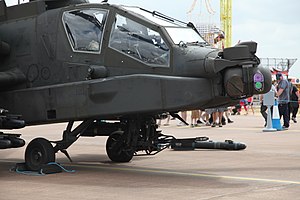Intevac: Difference between revisions
mNo edit summary |
mNo edit summary |
||
| (2 intermediate revisions by the same user not shown) | |||
| Line 1: | Line 1: | ||
[[File:High-Res IVAC Logo.png|alt=Logo|thumb|Logo of Intevac, Inc.]] | |||
Intevac Photonics, a subsidiary of EOTECH, is a manufacturer of night vision sensors and devices based in Santa Clara, CA, U.S.A. | |||
== History == | == History == | ||
Varian Associates Inc. was founded in 1948. It produced vacuum tubes which could amplify electromagnetic waves at microwave frequencies, and other electromagnetic equipment.<ref>https://en.wikipedia.org/wiki/Varian_Associates</ref> | Varian Associates Inc. was founded in 1948. It produced vacuum tubes which could amplify electromagnetic waves at microwave frequencies, and other electromagnetic equipment.<ref>https://en.wikipedia.org/wiki/Varian_Associates</ref> | ||
| Line 5: | Line 8: | ||
In 1991, the spinoff Intevac, Inc. was founded.<ref>https://en.wikipedia.org/wiki/Intevac</ref> | In 1991, the spinoff Intevac, Inc. was founded.<ref>https://en.wikipedia.org/wiki/Intevac</ref> | ||
[[File:Front section of parked apache helicopter at RIAT 2013.jpg|alt=AH-64 Apache helicopter sensor array|thumb|Parked AH-64 Apache attack helicopter, showing the sensor array that includes EBAPS sensors.]] | |||
In 2013, the U.S. awarded a contract to deliver Pilot Night Vision Sensors (PNVS) for the Apache helicopter to Intevac Photonics, using their patented EBAPS sensors.<ref>https://www.army-technology.com/news/newsintevac-supply-night-vision-cameras-us-army-apache/</ref> | In 2013, the U.S. awarded a contract to deliver Pilot Night Vision Sensors (PNVS) for the Apache helicopter to Intevac Photonics, using their patented EBAPS sensors.<ref>https://www.army-technology.com/news/newsintevac-supply-night-vision-cameras-us-army-apache/</ref> | ||
The Intevac Photonics was sold to EOTECH in December 2021.<ref>https://www.photonics.com/Articles/Intevac_Sells_Photonics_Business_to_EOTECH/a67653</ref> | The Intevac Photonics subsidiary was sold to EOTECH in December 2021.<ref>https://www.photonics.com/Articles/Intevac_Sells_Photonics_Business_to_EOTECH/a67653</ref> | ||
The contract to produce the Modernized Pilot Night Vision Sensor (M-PNVS) was awarded to Intevac Photonics in October 2021.<ref>https://www.army-technology.com/news/intevac-new-order-us-army-apache-programme/</ref> | The contract to produce the Modernized Pilot Night Vision Sensor (M-PNVS) was awarded to Intevac Photonics in October 2021.<ref>https://www.army-technology.com/news/intevac-new-order-us-army-apache-programme/</ref> | ||
| Line 21: | Line 24: | ||
== References == | == References == | ||
<references /> | <references /> | ||
__FORCETOC__ | |||
[[Category:Manufacturers]] | |||
[[Category:Image Intensifier Manufacturers]] | |||
Latest revision as of 19:38, 3 October 2023

Intevac Photonics, a subsidiary of EOTECH, is a manufacturer of night vision sensors and devices based in Santa Clara, CA, U.S.A.
History
Varian Associates Inc. was founded in 1948. It produced vacuum tubes which could amplify electromagnetic waves at microwave frequencies, and other electromagnetic equipment.[1]
It produced image intensifier tubes for the U.S. military as part of Omni II (and possibly both earlier and later) contracts.
In 1991, the spinoff Intevac, Inc. was founded.[2]

In 2013, the U.S. awarded a contract to deliver Pilot Night Vision Sensors (PNVS) for the Apache helicopter to Intevac Photonics, using their patented EBAPS sensors.[3]
The Intevac Photonics subsidiary was sold to EOTECH in December 2021.[4]
The contract to produce the Modernized Pilot Night Vision Sensor (M-PNVS) was awarded to Intevac Photonics in October 2021.[5]
EBAPS
EBAPS, short for Electron Bombarded Active Pixel Sensor, is a registered trademark for a patented technology by Intevac.
EBAPS sensors are digital night vision sensors that surpass the performance of analog image intensifiers.
An EBAPS sensor consists of a GaAs photocathode combined with a CMOS Active Pixel Sensor (APS) using the Electron Bombarded Semiconductor (EBS) gain process, which requires no MCP, achieving extremely low noise.[6]
References
- ↑ https://en.wikipedia.org/wiki/Varian_Associates
- ↑ https://en.wikipedia.org/wiki/Intevac
- ↑ https://www.army-technology.com/news/newsintevac-supply-night-vision-cameras-us-army-apache/
- ↑ https://www.photonics.com/Articles/Intevac_Sells_Photonics_Business_to_EOTECH/a67653
- ↑ https://www.army-technology.com/news/intevac-new-order-us-army-apache-programme/
- ↑ https://www.semanticscholar.org/paper/EBAPS-%C2%AE-%3A-Next-Generation%2C-Low-Power%2C-Digital-Night-Aebi-Costello/002b4258a6ebc2bca32cb725a87904ff28a11c09